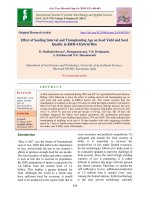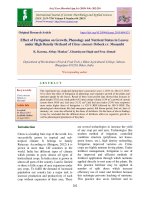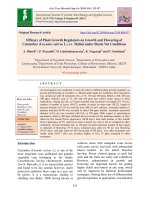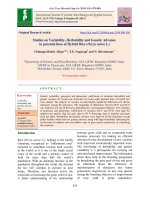Effects of gamma irradiation on shoot, root and survival percent in strawberry cv. chandler under in vitro conditions
Bạn đang xem bản rút gọn của tài liệu. Xem và tải ngay bản đầy đủ của tài liệu tại đây (772.64 KB, 10 trang )
Int.J.Curr.Microbiol.App.Sci (2018) 7(3): 1173-1182
International Journal of Current Microbiology and Applied Sciences
ISSN: 2319-7706 Volume 7 Number 03 (2018)
Journal homepage:
Original Research Article
/>
Effects of Gamma Irradiation on Shoot, Root and Survival Percent in
Strawberry cv. Chandler under In vitro Conditions
Rucku Gupta*, V.K. Wali, Parshant Bakshi, Guruupkar Singh,
Rafiq Ahmad Shah and Sohnika Rani
Division of Fruit Science, Sher-e-Kashmir University of Agricultural Sciences & Technology
of Jammu, Faculty of Agriculture, Main Campus, Chatha, Jammu-180009, India
*Corresponding author
ABSTRACT
Keywords
Gamma irradiation,
Strawberry, in vitro
Article Info
Accepted:
10 February 2018
Available Online:
10 March 2018
The effects of different doses (0, 10, 30, 50 and 60 Gy) of radioactive cobalt ( 60Co) rays on
axillary buds of strawberry were investigated under in vitro conditions. The results showed
that irradiated buds had increased shoot proliferation percentage, average number of
shoots, shoot length, average number of roots, root length, root initiation percentage,
survival percentage and number of leaves. However, at higher doses it showed inhibitory
effects and significant decreases in all above parameters was observed. The highest shoot
proliferation per cent (91.06 %), average number of shoots (8.44) and shoot length (2.77
cm) was recorded when buds were irradiated with 10 Gy gamma dose followed by 30 Gy
gamma dose. Gamma doses over 30 Gy resulted in sharp decreases in all parameters
examined. The highest root initiation percentage (91.06 %), average number of roots
(5.58) and root lengths (3.62 cm) was recorded from 10 Gy gamma rays. After 7 weeks of
hardening maximum survival per cent (86.66 %) was recorded in un-irradiated (control)
buds followed by buds irradiated with 10 Gy dose whereas, maximum number of leaves
were recorded in case of cultures irradiated with 10 Gy. Thus it can be concluded that
lower doses of gamma rays can improve the survival and growth of explants under in vitro
conditions.
Introduction
The genus Fragaria, from the family
Rosaceae is a dicotyledonus, perennial herb
grown in most arable regions of the world.
The cultivated strawberry has evolved as
natural hybrid between the F.virginiana Duch
and F. chiloensis (L) Duch. There are about 20
recognized species of strawberries in five
chromosomes groups (x=7): ten diploids, four
tetrapolids, one pentaploid, one hexaploid and
four octoploids. The cultivated strawberry is
an octoploid (2n=8x=56). In recent past,
strawberry has drawn attention of scientists for
its genetic improvement.
Plant tissue culture tools have been used for
increasing the speed and efficiency of the
breeding process, to improve the accessibility
of the existing germplasm and to create new
1173
Int.J.Curr.Microbiol.App.Sci (2018) 7(3): 1173-1182
variations for crop improvement through
micro-propagation, anther culture, in vitro
selection (Karim et al., 2015).
Induction of mutations using in vitro cultures
and micropropagation of desirable mutants
offers an alternative choice to broaden the
spectrum of genetic variation among
vegetatively propagated plants such as
strawberry. Induced mutations with gamma
irradiation and chemical mutagenesis provides
an excellent tool for the rapid creation and
increase in the variability in crop species and
thus have contributed significantly to plant
improvement. Gamma rays as an ionizing
radiation affect plant growth and development
by inducing cytological, biochemical,
physiological and morphological changes in
cells and tissues via producing free radicals in
cells (Gunckel and Sparrow, 1961; Kim et al.,
2004; Wi et al., 2005). The higher doses of
gamma radiation had been found be inhibitory
(Radhadevi and Nayar, 1996; Kumari and
Singh, 1996), whereas, lower doses may be
stimulatory. Low doses of gamma rays have
been reported to increase cell proliferation,
germination, cell growth, enzyme activity,
stress resistance, and crop yields (Charbaji and
Nabulsi, 1999; Baek et al., 2005; Chakravarty
and Sen, 2001; Kim et al., 2000, 2005).
Therefore, this study was aimed to determine
the optimum dose of gamma rays for
improving shoot, root and survival per cent of
strawberry under in vitro conditions.
Materials and Methods
The present study was conducted at Tissue
Culture Laboratory, Division of Fruit Science,
Sher-e-Kashmir University of Agricultural
Sciences & Technology of Jammu, Jammu
during the year 2015- 2016. The axillary buds
of strawberry plants were used as the starting
material for in vitro grown cultures. Axillary
bud cultures (25 buds/ culture bottle) were
used as replicates for each treatment. Before
irradiated the cultures, the axillary buds were
washed thoroughly in running tap water for 20
minutes to remove the surface contaminants
and was then treated with Tween 20 (2-3
drops/100 ml of H2O) for 4-5 minutes and
washed thoroughly with distilled water. After
that, the washed buds were treated with
(0.5%) bavistin for 6-7 minutes and then
washed 3-4 times with distilled water. Finally,
sterilization procedures were carried out under
aspectic conditions in a laminar- air flow
cabinet. The axillary buds were subjected to
surface sterilization using mercuric chloride
(0.1%) for 4 minutes. The axillary buds were
then cultured on MS media supplemented with
BAP (1.00 mg/l) in combination with GA3
(1.00 mg/l) which was already standardized
before irradiating the explants with different
dosage of gamma rays and same media
composition was used for shoot proliferation
also.
In vitro mutagenesis was carried out by
irradiating the cultures with different doses of
gamma rays in gamma chamber at Punjab
Agriculture University, Ludhiana. The gamma
ray treatment was performed using blood
Irradiator (60Co source, Dose 11 Gy per
minute). The axillary buds were irradiated
with four doses of gamma rays viz., 10, 30, 50,
60 Gy for induction of mutations. The Gamma
ray irradiated axillary buds were cultured on
growing media for shoot proliferation and
were then transferred to rooting medium (MS
medium supplemented with IBA 1. 5mg/l and
activated charcoal 200 mg/l). The miniature
explants were hardened and grown in
glasshouse in pots containing soil: FYM (1:1
v/v) for 7 weeks. The effect of gamma
irradiation on the proliferation percentage,
average number of shoots, shoot length after 8
weeks of culturing, root initiation percentage,
average number of roots, root length after 6
weeks of culturing and the per cent survival
and number of leaves after 7 weeks of
transferring were recorded as per the
1174
Int.J.Curr.Microbiol.App.Sci (2018) 7(3): 1173-1182
standardized methods. The data were analysed
according to completely Randomized Block
design (CRD) as described by Panse and
Sukhatme (2000).
Results and Discussion
The in vitro mutagenesis was carried out by
irradiating the cultures with the gamma rays at
four doses viz., 10, 30, 50 and 60 Gy. The
staring material used was axillary buds. None
of the doses were found to be lethal as axillary
buds grew normally after irradiation. The
effects of gamma doses on shoot proliferation
percentage after 4 weeks of incubation,
average number of shoots and shoot length
after 6 weeks of culturing are shown in Table
1 and depicted in Figure 1.
Stimulatory effect of low doses of gamma
irradiation on all parameters was observed in
case of cultures irradiated with 10 Gy and
cultures irradiated with 30 Gy. However, the
inhibitory effect of gamma radiation on shoot
proliferation percentage, average number of
shoots and shoot length was observed in the
doses over 30 Gy. The highest shoot
proliferation per cent, maximum average
number of shoots and shoot length was 91.06
%, 8.22 cm and 2.77 cm respectively from the
10 Gy gamma treatments.
The results obtained in the present
investigation are similar to those of Charbaji
and Nabulsi (1999) in grapevine (Vitis vinifera
L). They observed that lower doses of gamma
rays (5, 7 Gy) stimulated the growth of the
shoot tip and single node explants. In the
present studies, the positive response of
strawberry to low dose (5 Gy) of gamma
irradiation agrees with the hypothesis
proposed by Fowler and McQueen (1972),
that the stimulatory effects of low doses of
irradiation result in increased seedling vigour.
Stimulation of growth with lower doses of
gamma rays has been reported in various
crops, such as Rudbeckia laciniata (Shukla et
al., 1986), Gerbera Jamesonii (Laneri et al.,
1990). Enhancement in multiplication ratio at
low doses (15 Gy) of Musa species have also
been reported by Kulkarni et al., (1997).
Similar trend has also been reported by Mishra
et al., (2007). Cambecedes et al., (1992) also
reported the decrease in ability to produce
shoots on increasing the radiation dose in
Lonicera species. Jain (1997) reported the
inhibitory effects of higher doses of gamma
rays on strawberry cultures. He found that
most dead number of shoots and < 1 cm long
was highest in shoot cultures developed from
15 KR irradiated axillary buds. They also
reported that the number of roots per shoot
decreased at higher gamma dosage (10 KR
and 15 KR). The increased plant vigour
caused by irradiation could be explained by
stimulation of biosynthesis of some amino
acids like Iysine and phenylalanine (Antonov
et al., 1989); modification of some enzymes
activity e.g. Polyphenol oxidase, catalases and
peroxidases which are great in the leaf of
treated plants (Lage and Esquibel, 1997;
Ghiorghita et al., 1985; Freidman, 1985,
Grossman and Craig, 1982) for increase of
primary biochemical processes, uptake of
mineral nutrients (Al-Oudat, 1990) and
photosynthesis (Antonov, 1985).
The per cent root initiation was also
influenced by gamma irradiation. The data
recorded on per cent root initiation at 14 days
interval i.e. after 14, 21 and 28 days after the
subculture is given in Table 2. Among the
different gamma irradiation doses, percent
root initiation after 28 days of sub-culturing
was 91.06 % in plantlets arising from 10 Gy,
that is more than control (86.63 %) while
plantlets arising from 60 Gy showed only
46.44 % root initiation. The data related to the
effect of irradiation on the roots parameters
are presented in Table 3. It was observed that
average number of roots and root length has
grown faster as shown in Figure 2.
1175
Int.J.Curr.Microbiol.App.Sci (2018) 7(3): 1173-1182
Table.1 Effect of different doses of gamma rays on shoot proliferation per cent, average number
of shoots and shoot length of strawberry cv. Chandler
Treatment
0 Gy
10 Gy
30 Gy
50 Gy
60 Gy
CD
Shooting
Proliferation (%)
82.20(65.10)
91.06(72.81)
86.66(68.98)
55.55(48.17)
46.66(43.17)
7.35
Average no. of shoot
6.51
8.44
7.22
5.23
4.62
0.40
Average shoot length
(cm)
2.22
2.77
2.55
1.66
1.44
0.25
Table.2 Effect of different doses of gamma rays on root initiation of strawberry cv. Chandler
Treatment
0 Gy
10 Gy
30 Gy
50 Gy
60 Gy
Mean
CD (0.05)
Root initiation per cent (%)
14 days
21 days`
28 days
53.30
64.40
86.63
57.76
66.63
91.06
51.06
55.53
73.30
39.96
53.30
64.40
28.83
35.53
46.63
46.18
55.08
72.40
Treatment : 6.34, Number of Days : 4.91
Treatment x number of days (Interaction) : N.S.
Mean
68.11
71.82
59.96
52.55
37.00
Table.3 Effect of different doses of gamma rays on the average root number and root length of
strawberry cv. Chandler
Treatment
0 Gy
10 Gy
30 Gy
50 Gy
60 Gy
CD
Average no. of root
5.25
5.58
3.54
2.81
1.84
0.39
Average root length (cm)
3.32
3.62
2.47
2.14
1.96
0.36
Table.4 Percent survival of irradiated strawberry plantlets of cv. chandler in glasshouse
Treatment
0 Gy
10 Gy
30 Gy
50 Gy
60 Gy
CD
Survival percentage
86.66(68.98)
75.55 (60.90)
68.88(56.28)
55.55(48.17)
46.66(43.05)
11.03
1176
No. of leaves
4.40
5.68
3.66
2.84
2.62
0.8
Int.J.Curr.Microbiol.App.Sci (2018) 7(3): 1173-1182
After 4 weeks of incubation
10Gy
30 Gy
50 Gy
60 Gy
After 6 weeks of culturing
10 Gy
30 Gy
1177
Int.J.Curr.Microbiol.App.Sci (2018) 7(3): 1173-1182
50 Gy
60 Gy
Fig.1 Effect of different doses of gamma irradiations on shoot parameters
10 Gy
30 Gy
50 Gy
60 Gy
1178
Int.J.Curr.Microbiol.App.Sci (2018) 7(3): 1173-1182
Fig.2 Effect of gamma rays on root characters of strawberry
10 Gy
30 Gy
50 Gy
60 Gy
10 Gy
30 Gy
50 Gy
60 Gy
1179
Int.J.Curr.Microbiol.App.Sci (2018) 7(3): 1173-1182
Fig.3 Hardening of rooted plantlets arising from different gamma rays doses
10 Gy
30 Gy
50 Gy
60 Gy
Maximum average number of roots (5.58)
was observed in cultures irradiated with 10
Gy and the minimum average number of roots
(1.84) was obtained in case of cultures
irradiated with 60 Gy. Regarding the root
length, same results were observed as
maximum root length (3.62 cm) was obtained
in case of cultures irradiated with 10 Gy. It
has been observed that as the dosage of
gamma rays increased the root parameters
decreased. Jain (1997) reported the inhibitory
effects of higher doses of gamma rays on
strawberry cultures. He found that the number
of roots per shoot decreased at higher gamma
dosage (10 KR and 15 KR).
The data as presented in Table 4 revealed that
the per cent survival of rooted plantlets was
significantly lower in the irradiated plantlets
than control. The highest per cent of survival
(86.66 %) was obtained in plantlets which
were not subjected to gamma irradiation
followed by 10 Gy (75.55 %). Whereas, the
lowest survival per cent was obtained in the
plantlets irradiated with 60 Gy (46.44 %). The
response of the irradiation was found to be
significantly different among different gamma
irradiation doses. The results regarding the
number of leaves after 7 weeks of hardening
were depicted in Figure 3. Maximum number
of leaves per plantlet differed significantly
with the dosage of gamma rays (Table 4) the
data mentioned here revealed that maximum
number of leaves per plantlet (5.68) were
observed in case of cultures irradiated with 10
Gy followed by 30 Gy. It must be emphasised
here that the young plants are very delicate
when first taken out of the tubes and must be
carefully handled (Mullin et al., 1974 and
Murashige, 1977). Tiwari and Kumar (2011)
observed higher percentage of survival at
lower doses and poor survival at higher doses
1180
Int.J.Curr.Microbiol.App.Sci (2018) 7(3): 1173-1182
in all the generations of Calendula officinalis.
Shukla et al., (1986) found the reduction
survival of plants after exposure to gamma
rays with the increase of dose in Rudbeckia
laciniata.
Stimulatory effects of low doses of gamma
rays on strawberry can be related to
hypothesis that the low dose irradiation
induce growth stimulation by changing the
hormonal signalling network in plant cells or
increase the anti-oxidative stress capacity of
the cells to easily overcome the stress factors
such as fluctuations of light intensity and
temperatures in the growth condition (Wi et
al., 2007). In contrast the high dose
irradiation that caused growth inhibition has
been ascribed to the cell cycle arrest at G2/ M
phase during somatic cell division and /or
various damages in the entire genome
(Preussa and Britta, 2003).
From the results, it could be concluded that
low doses of gamma radiation could simply
be used for better survival and growth in
strawberry under in vitro conditions.
References
Al-Oudat M. 1990. Effect of low dose
gamma irradiation on onion yield.
Annals of Biology 6: 61– 67
Antonov M Velichov P Tsonev T S and
Angelov M. 1989. Effect of gamma
and laser irradiation on maize seeds
and plants. ESNA, XXth Annual
Meeting, Wageningen, the Netherlands
pp-44.
Antonov M. 1985. Effect of gamma
irradiation and storage duration of
maize seeds on certain biochemical
changes in the grain, Pasteniev. D.
Nauki 19–24
Baek M H Kim J H Chung B Y Kim J S Lee I
S. 2005. Alleviation of salt stress by
low dose g-irradiation in rice. Biologia
Plantarum, 49 (2), 273-276.
Cambecedes J Duron M Decourtye L and
Jalouzot R. 1992. Methodology of In
vitro irradiation from Lonicera species,
mutant description and biochemical
characterisation. Acta Horticulturae
320:119–126.
Fowler D B and MacQueen K F. 1972. Effect
of lower doses of, radiation on yield and
other agronomic characters of spring
wheat. Radiation Botany 12:349–353.
Freidman, S. T. 1985. Pre-sowing radiation
stimulation of crop seeds. ESNA
Newsletter, pp.126– 148. Warszawa
Ghiorghita, A G I Toth E T and Popescu T T
1985. The influence of physiological
stage of seeds at the irradiation
moment on the effects induced by
small doses of gamma rays 60Co in
Triticum aestivum. Rev. Roum. Biol.
Ser. Biol. Veg. 30: 151–158
Grossman H H and Craig R. 1982. The effect
of gamma irradiation of seeds on
germination and plant morphology of
Pelargonium hortorum L.H. Bailey.
Journal of American Society for
Horticultural Sciences 107: 72–75
Gunckel J E Sparrow A H. 1961. Encycl.
Plant Physiology. In: Ruhland, W.
(Ed.), Ionizing Radiation: Biochemical,
Physiological
and
Morphological
Aspects of Their Effects on Plants.
Springer-Verlag, Berlin, pp. 555.
Jain S M. 1997. Creation of variability by
mutation and tissue culture for
improving plants. Acta Horticulturae
447:69-77
Karim R Ahmed F Krishna U Roy Ara T
Islam R and Hossain M. 2015. Varietal
improvement of strawberry (Fragaria x
ananassa Dutch.) through somaclonal
variation using in vitro techniques.
Journal of Agricultural Sciences and
Technology 17: 977-986.
1181
Int.J.Curr.Microbiol.App.Sci (2018) 7(3): 1173-1182
Kim J H Baek M H Chung B Y Wi S G Kim J
S.
2004.
Alterations
in
the
photosynthetic
pigments
and
antioxidant machineries of red pepper
(Capsicum annuum L.) seedlings from
gamma-irradiated seeds. Journal of
Plant Biology 47: 314-321.
Kim J H Chung B Y Kim J S Wi S G. 2005.
Effects of in Planta gamma-irradiation
on
growth,
photosynthesis,
and
antioxidative capacity of red pepper
(Capsicum annuum L.) plants. Journal
of Plant Biology 48: 47-56
Kim J S Lee Y K Park H S Back M H Kim D
H. 2000. Influence of low dose gamma
radiation on the growth of maize (Zea
mays L.) varieties Korean. Journal of
Environment and Agriculture 19: 328331.
Lage L S C and Esquibel M A. 1997.
Growth stimulation produced by
methylene blue treatment in sweet
potato. Plant Cell Tissue Organ
Culture, 48: 77–81.
Laneri U franconi R and Altvista P. 1990.
Somatic mutagenesis of Gerbers
jamesonii Hybr. Irradiation and in vitro
culture. Acta horticulturae 280:395–
402.
Mishra P J Ganapathi T R Suprasanna P and
Bapa V A. 2007. Effect of Single and
Recurrent Gamma Irradiation on in
vitro Shoot Cultures of Banana.
International Journal of Fruit Science
7(1):47-57.
Mullin R. H Smith S H Frazier N W Schlegel
D E and MacCall S R. 1974. Meristem
culture frees strawberries of mild
yellow edge, pallidosis and mottle
diseases. Phytopathology 64: 14251429.
Murashige T. 1997. Plant cell and organ
culture as horticultural practices. Acta
Horticulturae, 78: 17-30.
Preussa S B and Britta A B. 2003. A
DNA‐ damage‐ induced cell cycle
checkpoint. Arabidopsis. Genetics, 164:
323‐ 334.
Radhadevi D S Nayar N K. 1996. Gamma
rays induced fruit character variations in
Nendran, a variety of banana (Musa
paradasiaca L.). Geobios 23: 88-93.
Shukla R Nath P Jugran H M and Gupta M N.
1986. Studies on gamma radiation of
Rudbeckia Laciniata cv. ‘Golden
Glow’. Journal of Nuclear Agriculture
and Biology 15 (4):207-210.
Tiwari A K and Kumar V. 2011. Gamma
ray induced morphological changes in
pot marigold (Calendula officinalis).
Progressive Agriculture, 11: 99-02
Wi S G Chung B Y and Kim J S. 2007.
'Effects of gamma irradiation on
morphological changes and biological
responses in plants'. Micron 38:
553‐ 564.
Wi, S.G., Chung, B.Y., Kim, J.H., Baek,
M.H., Yang, D.H., Lee, J.W., Kim, J.S.,
2005. Ultrastructural changes of cell
organelles in Arabidopsis stem after
gamma irradiation. J. Plant Biol. 48,
195-200.
How to cite this article:
Rucku Gupta, V.K. Wali, Parshant Bakshi, Guruupkar Singh, Rafiq Ahmad Shah and Sohnika
Rani. 2018. Effects of Gamma Irradiation on Shoot, Root and Survival Percent in Strawberry
cv. Chandler under In vitro Conditions. Int.J.Curr.Microbiol.App.Sci. 7(03): 1173-1182.
doi: />
1182









